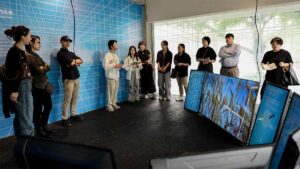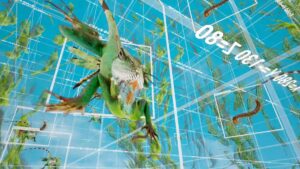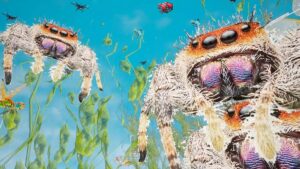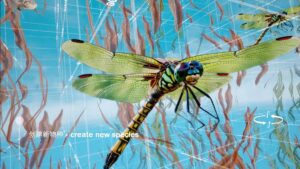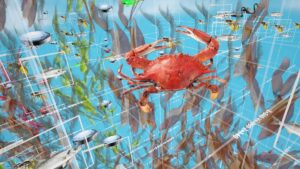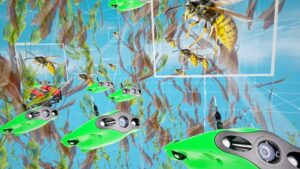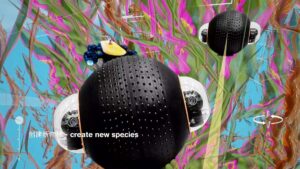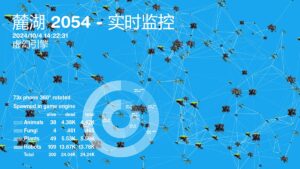Mobile App as Interface for Network-Based Multi-Screen Installation
Luxelakes 2054 imagines a speculative ecosystem 30 years from now, where artificial intelligence, biotechnologies and robotics work together to create and optimize species to withstand the increasingly hostile environment. With the help of local people, we collected and mapped natural observation in the Luxelakes ecosystem and integrated them to a mobile app. From the perspective of an AI simulator, the audience is invited to create new variations of those animals, fungi and plants, fly with these species as well as robots through a changing ecosystem. Luxelakes 2054 responds to the trend of technology-assisted solution-making by constructing narratives of an uncomputable system under extreme control – what do we optimize, and what are we ignoring as a result? The project aims to inspect our tendency to simplify complex ecosystems by treating nature as a system that can be fixed.
Description
Luxelakes 2054 was created during a residency at the A4 Residency Art Center in Chengdu. It builds on the Speculative Evolution series, including CAON and YANTO in combination with the real-time cartography project Used to Be My Home Too. As part of this research series, several scientific institutions were visited, including laboratories where genetic modification of animals is being researched. A4 Residency Art Center is situated within the Luxelakes Eco-city, a town-scale environment encompasses the world’s largest artificial lake, which covers an area of 1.5 square kilometers, as well as parks, residential communities, schools, and other facilities. The Luxelakes ecosystem is completely human built and cannot sustain itself without human intervention. It is a significant challenge to maintain this artificial ecosystem and requires numerous advanced technologies. Meetings with landscape architects and water specialists from the Chengdu Urban Rivers Association helped us to better understand the complexity of the system.
With this research and the help of local people, we collected and mapped natural observation in the Luxelakes ecosystem and integrated them to a mobile app. We speculate what might Luxelakes Eco-city look like in the future, 30 years from now, when our technological possibilities such as genetic engineering, synthetic biology, 3D printing, robotics and artificial intelligence are much more advanced. If AI agents could combine these technologies to calculate and balance the entire ecosystem, what results would they achieve, and how would Luxelake look and sound like? Machine learning and biotechnologies are currently used to identify, monitor, and map species, as well as create new genetic traits. It’s not hard to imagine a not-so-distant future where AI does the balancing act of optimizing for human objectives. We believe that this is not a utopia or a dystopia, but rather a direction in which we are heading.
The overall purpose of that project was guided by environmental challenges as they occurred in real life in the Luxelakes ecosystem. We created an alternative cartography with alternative scales that served as testing grounds to a) investigate assumptions about technical solutions to improve the quality of life, b) challenge our tendency to simplify complex ecosystems by treating nature as a system that could be calculated and fixed, and c) explore radical future scenarios. For this, the Luxelakes Eco-city environment had been an ideal testing ground.
Audience Experience and Impact
The audience interact with the installation through a mobile interface and navigate through a speculative 3D environment. This virtual environment is endless and can be navigated in every direction. The sonic sound experiences are specially composed for this simulation and respond to all movements and navigation modes.
In this experiment, the audience can use a DALL-E integration to create new animal, fungi, plant and robot variations. The audience can observe how new creatures might look like when artificial intelligence is used to create and optimize them, and how they impact the ecosystem. Through the point-of-view of an A.I. simulator, the audiences are invited to fly through the 3D environment with the engineered/mutated species and observe the changing ecosystem. As the audience approaches a species, the species’ names, lineages, populations and backstories are displayed on the portrait screens. We hope to invite the audience to investigate our tendency to engineer nature and treat ecosystems as a system that can be fixed.
Screenshots
Mobile app Luxelakes 2054
In the mobile app we use the utility-based agent strategy, inspired by Artificial Intelligence: A Modern Approach by Stuart Russell and Peter Norvig, 1995
A program that interacts with its environment by perceiving its surroundings through sensors and then acting through actuators, to go through the cycles of perception, calculation, action and improvement.
- Perception
- Data Acquisition: The following aspects are taken into account: The number and relationship of animal, fungi and plant species, the number of variations of each species, how often they appear and disappear, how often users click, filter and force each variation, the flight behavior in the 3D environment and how often the mobile phone is rotated 360 degrees.
- Data Preprocessing: The collected data is pre-processed for quality control and converted into a machine-readable format for my consumption.
- Calculation
- Ecosystem Modeling: Utilizing preprocessed data, I construct a computational model of the ecosystem.
- Simulation and Prediction: This model is employed to simulate current ecological states and predict the potential consequences of various management actions.
- Action Selection: Based on these simulations and predictions, I leverage a pre-defined utility function to select actions that maximize the desired ecological outcome. This function mathematically represents the specific environmental goals of biodiversity and population balance.
- Action
- Based on the calculated ratings, I decide which actions should be taken to balance, control and improve the ecosystem.
- The actions can balance population figures or diversity.
- I prioritize actions based on the expected benefit for the ecosystem and the available resources.
- Continuous Improvement
- The perception, computation, and action cycle operates in a closed-loop fashion, enabling continuous adaptation.
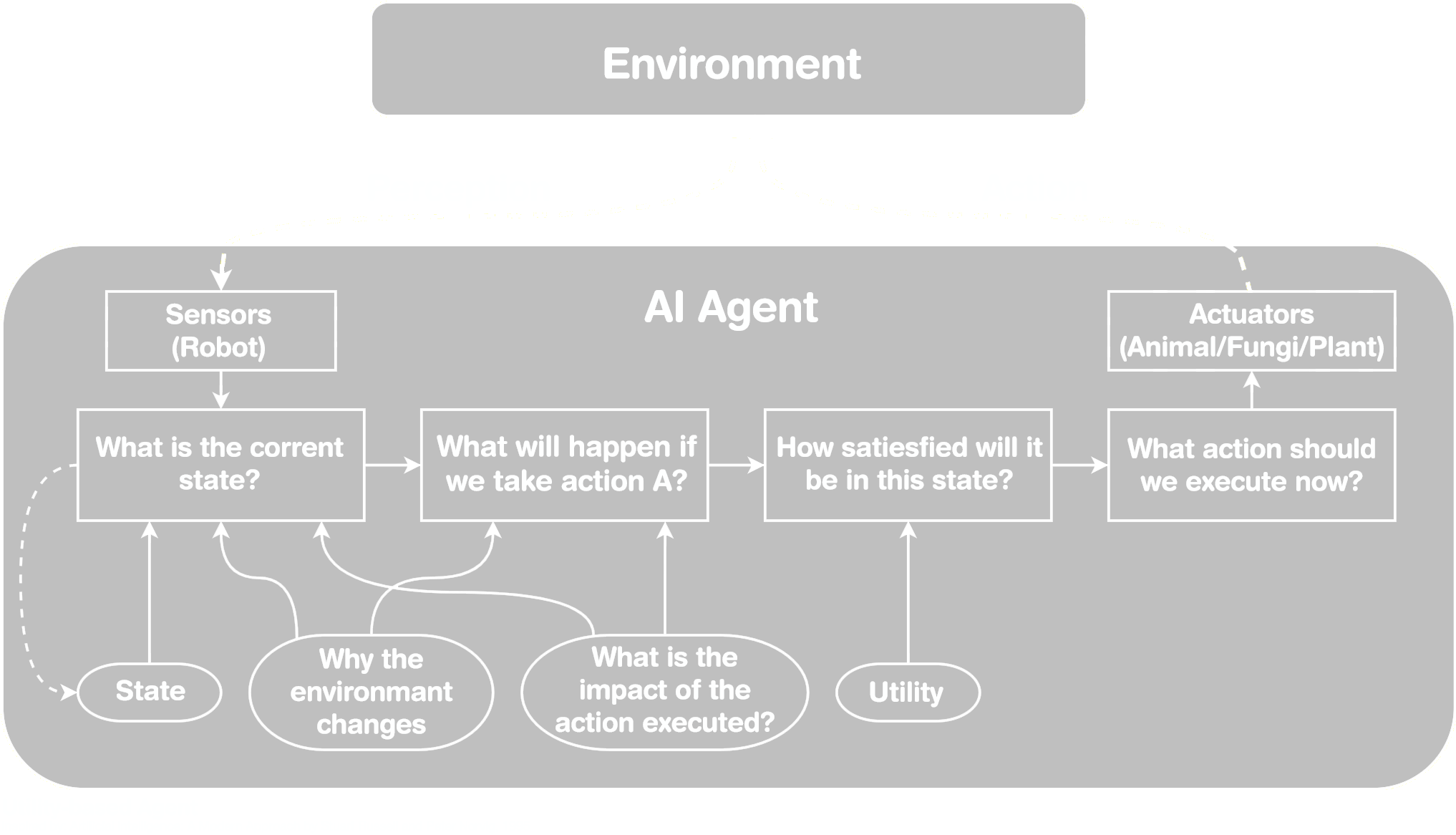
By following this strategy, AI-Agents try to effectively balance an ecosystem and ultimately optimize its stability and resilience. The project aims to inspect our tendency to simplify complex ecosystems by treating nature as a system that can be fixed.


